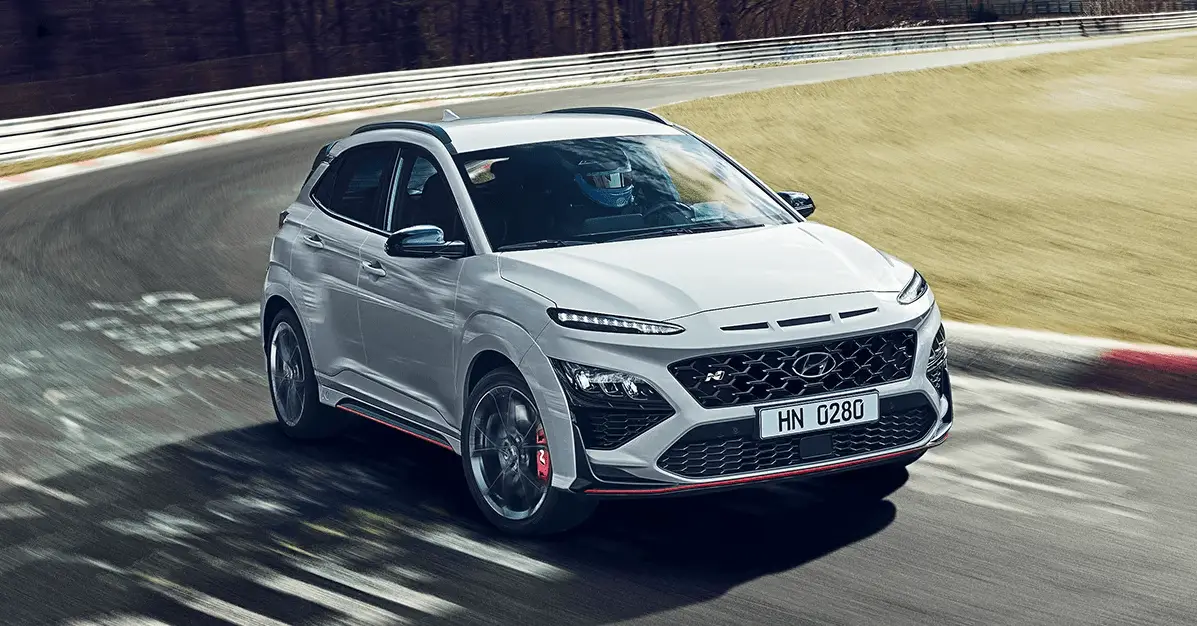2023 Hyundai Kona-N Forward Collision-Avoidance Assist (FCA) (Front View Camera Only)
Forward Collision-Avoidance Assist, a new technology in the 2023 Hyundai Kona-N, takes safety to a level that has never been reached before. It is a game-changer that will change the way people think about avoiding accidents. With a strong commitment to the safety of the driver and passengers, this high-tech feature uses sensors and complex algorithms to predict possible frontal accidents. The Forward Collision-Avoidance Assist technology is like a watchful co-pilot, always looking ahead for obstacles, other cars, and people. If a crash is about to happen, it quickly warns the driver and, if necessary, takes action by applying the brakes on its own to lessen the impact or even stop the crash from happening. Forward Collision-Avoidance Assist, which acts as a guardian angel on the road, shows how committed Hyundai is to not only giving the 2023 Kona-N thrilling performance but also making sure that every trip is as safe as possible.
2023 HYUNDAI KONA Specs, Price, Features, Milage (brochure)
Forward Collision-Avoidance Assist (FCA) (Front View Camera Only)

Forward Collision-Avoidance Assist is designed to help detect and monitor the vehicle ahead or help detect a pedestrian in the roadway and warn the driver that a collision is imminent with a warning message and an audible warning and application of emergency braking.
Detecting sensor
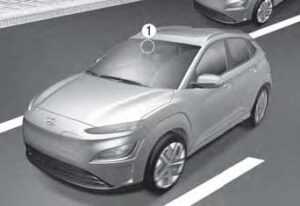
[1]: Front view camera
Refer to the picture above for the detailed location of the detecting sensors.
CAUTION
Take the following precautions to maintain optimal performance of the detecting sensor:
- Never disassemble the detecting sensor or sensor assembly, or apply any impact on it.
- If the detecting sensors have been replaced or repaired, have your vehicle inspected by an authorized HYUNDAI dealer.
- Never install any accessories or stickers on the front windshield, or tint the front windshield.
- Exercise extreme caution to keep the front view camera dry.
- Never place any reflective objects (for example, white paper, a mirror) over the dashboard.
Forward Collision-Avoidance Assist Settings
Setting features
[1]: Front view camera
Refer to the picture above for the detailed location of the detecting sensors.
CAUTION
Take the following precautions to maintain optimal performance of the detecting sensor:
- Never disassemble the detecting sensor or sensor assembly, or apply any impact on it.
- If the detecting sensors have been replaced or repaired, have your vehicle inspected by an authorized HYUNDAI dealer.
- Never install any accessories or stickers on the front windshield, or tint the front windshield.
- Exercise extreme caution to keep the front view camera dry.
- Never place any reflective objects (for example, white paper, a mirror) over the dashboard.
Forward Collision-Avoidance Assist Settings
Setting features
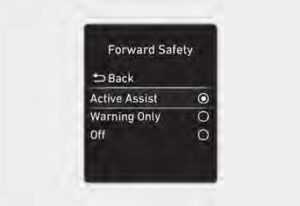
Forward Safety
With the vehicle on, select or deselect the Settings menu to set whether or not to use each function.
- Collision-Avoidance Assist will warn the driver with a warning message and an audible warning depending on the collision risk levels. Braking assist or steering assist (if equipped) will be applied depending on the collision risk.
- Collision-Avoidance Assist will warn the driver with a warning message, an audible warning depending on the collision risk levels. Braking and steering (if equipped) will not be assisted. The driver must apply the brake pedal or steer the vehicle if necessary.
- Avoidance Assist will turn off. The warning light will illuminate on the cluster.
- The driver can monitor Forward Collision-Avoidance Assist ON/OFF status from the Settings menu. If the warning light remains ON when Forward Collision-Avoidance Assist is ON, have the vehicle inspected by an authorized HYUNDAI dealer.
- When the vehicle is restarted, Forward Collision-Avoidance Assist will always turn on. However, if ‘Off’ is selected, the driver should always be aware of the surroundings and drive safely.
CAUTION
If ‘Warning Only’ is selected, braking and steering (if equipped) is not assisted.
Information
Forward Collision-Avoidance Assist will turn off when ESC is turned off by pressing and holding the ESC OFF button. The warning light will illuminate on the cluster.

Warning Timing
With the vehicle on, select ‘The driver Settings menu to change the initial warning activation time for Forward Collision-Avoidance Assist. When the vehicle is first delivered, change the Warning Timing, the warning time of other Driver Assistance systems may change.

Warning Volume
With the vehicle on, select ‘Driver Avoidance Assist. If you change the Warning Volume, the warning volume of other Driver Assistance systems may change.
CAUTION
- The setting of the Warning Timing all functions of Forward Collision-Avoidance Assist.
- Even though ‘Normal’ is selected for Warning Timing, if the front vehicle suddenly stops, the initial warning activation time may seem late.
- Select ‘Late’ for Warning Timing when traffic is light and when driving speed is slow.
Information
If the vehicle is restarted, Warning Timing and Warning Volume will maintain the last setting.
Forward Collision-Avoidance Assist Operation
Basic function Warning and Control
The basic function of Forward Collision-Avoidance Assist is to warn and control the vehicle depending on the collision
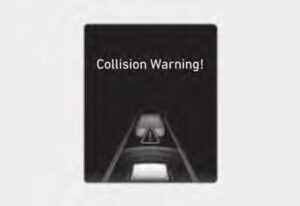
Collision Warning
- To warn the driver of a collision, the will appear on the cluster, an audible warning will sound.
- If a vehicle is detected in front, the function will operate when your vehicle speed is between approximately 6~112 mph (10~180 km/h).
- If a pedestrian or cyclist is detected in front, the function will operate when your vehicle speed is between approximately 6~37 mph (10~60 km/h).
- If active assist may be assisted.
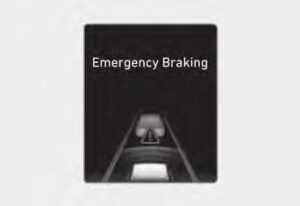
Emergency Braking
- To warn the driver that emergency braking will be assisted, the message will appear on the cluster, an audible warning will sound.
- If a vehicle is detected in front, the function will operate when your vehicle speed is between approximately 6~37 mph (10~60 km/h).
- If a pedestrian is detected in front, the function will operate when your vehicle speed is between approximately 6~37 mph (10~60 km/h).
- In emergency braking situations, braking is assisted with strong braking power by the function to help prevent collision with the vehicle, or pedestrian ahead.

Stopping the vehicle and ending the brake control
- When the vehicle is stopped due to emergency braking, the ‘Drive appears on the cluster.
For your safety, the driver should depress the brake pedal immediately and check the surroundings. - Brake control will end after the vehicle is stopped by emergency braking for approximately 2 seconds.
Warning
- For your safety, only change the Settings after parking the vehicle at a safe location.
- With ‘Active Assist’ or ‘Warning Only’ selected, when ESC is turned off by pressing and holding the ESC OFF button, Forward Collision-Avoidance Assist will turn off automatically.
- In this case, Forward Collision-Avoidance Assist cannot be set from the Settings menu and the warning light will illuminate on the cluster which is normal. If ESC is turned on by pressing the ESC OFF button,
- Forward Collision-Avoidance Assist will maintain the last setting.
- Forward Collision-Avoidance Assist does not operate in all situations and cannot avoid all collisions.
- The driver has the responsibility to control the vehicle. Do not solely depend on Forward Collision-Avoidance Assist. Rather, maintain a safe braking distance, and if necessary, depress the brake pedal to reduce driving speed or to stop the vehicle.
- Never deliberately operate Forward Collision-Avoidance Assist on people, objects, etc. It may cause serious injury or death.
- Forward Collision-Avoidance Assist may not operate if the driver depresses the brake pedal to avoid a collision.
Forward Collision-Avoidance Assist malfunction

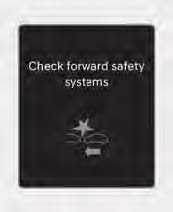
When Forward Collision-Avoidance Assist is not working properly, the ‘Check message will appear, and the and warning lights will illuminate on the cluster. Have the vehicle be inspected by an authorized HYUNDAI dealer.
Forward Collision-Avoidance Assist disabled
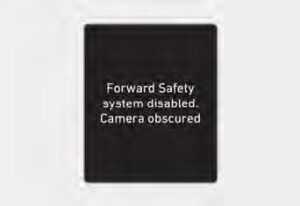
When the front windshield where the front view camera is located, front radar cover, bumper, or sensor is covered with foreign material, such as snow or rain, it can reduce the detecting performance and temporarily limit or disable Forward Collision-Avoidance Assist. If this occurs the ‘Forward Safety system message, and the warning lights will illuminate on the cluster. Forward Collision-Avoidance Assist will operate normally when snow, rain, or foreign material is removed. If Forward Collision-Avoidance Assist does not operate normally after obstruction (snow, rain, or foreign material) is removed, have the vehicle inspected by an authorized HYUNDAI dealer.
Warning
- Even though the warning message or warning light does not appear on the cluster, Forward Collision-Avoidance Assist may not properly operate.
- Forward Collision-Avoidance Assist may not properly operate in an area (for example, open terrain), where any objects are not detected after turning ON the vehicle.
Limitations of Forward Collision-Avoidance Assist
Forward Collision-Avoidance Assist may not operate normally, or it may operate unexpectedly under the following circumstances:
- The detecting sensor or the surroundings are contaminated or damaged
- The temperature around the front view camera is high or low
- The camera lens is contaminated due to tinted, filmed or coated windshield, damaged glass, or foreign material (sticker, bug, etc.) on the glass
- Moisture is not removed or frozen on the windshield
- Washer fluid is continuously sprayed, or the wiper is on
- Driving in heavy rain or snow, or thick fog
- The field of view of the front view camera is obstructed by sun glare
- Street light or light from oncoming traffic is reflected on the wet road surface, such as a puddle on the road
- The vehicle in front has no tail lights, tail lights are located unusually, etc.
- The brightness outside is low, and the tail lamps are not on or are not bright
- The rear of the front vehicle is small or the vehicle does not look normal, such as when the vehicle is tilted, overturned, or the side of the vehicle is visble, etc.
- A vehicle, pedestrian suddenly cuts in front
- The vehicle in front is detected late
- The vehicle in front is suddenly blocked by an obstacle
- The vehicle in front suddenly changes lane or suddenly reduces the speed
- The vehicle in front is bent out of shape slow
- The vehicle in front steers in the opposite direction of your vehicle to avoid a collision
- With a vehicle in front, your vehicle changes lane at low speed
- The vehicle in front is covered with snow
- You are departing or returning to the lane
- Unstable driving
- You are on a roundabout and the vehicle in front is not detected
- You are continuously driving in a circle
- The vehicle in front has an unusual shape
- The vehicle in front is driving uphill or downhill
- The pedestrian is not fully detected, for example, if the pedestrian is leaning over or is not fully walking upright
- The pedestrian is wearing clothing or equipment that makes it difficult to detect.
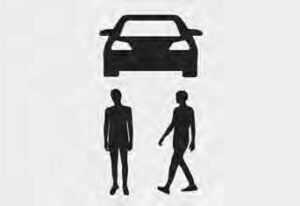
The illustration above shows the image the front view camera and front radar is capable of detecting as a vehicle and pedestrian.
- The pedestrian in front is moving very quickly
- The pedestrian in front is short or is posing a low posture
- The pedestrian in front has impaired mobility
- The pedestrian in front is moving intersected with the driving direction
- The pedestrian is difficult to distinguish from the similarly shaped structure in the surroundings
- You are driving by a pedestrian, traffic signs, structures, etc. near the intersection
- Driving in a parking lot
- Driving through a tollgate, construction area, unpaved road, partially paved road, uneven road, speed bumps, etc.
- Driving on an inclined road, curved road, etc.
- Driving through a roadside with trees or streetlights
- The adverse road conditions cause excessive vehicle vibrations while driving
- Driving through a narrow road where trees or grass are overgrown
- There is interference by electromagnetic waves, such as driving in an area with strong radio waves or electrical noise
Warning
- Driving on a curved road
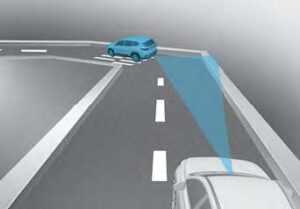
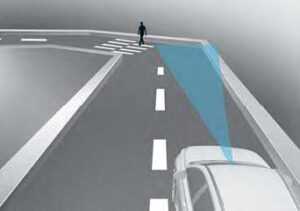
Forward Collision-Avoidance Assist may not detect other vehicles, or pedestrians in front of you on curved roads adversely affecting the performance of the sensors. This may result in no warning, braking assist or steering assist (if equipped) when driving.
When driving on a curve, you must maintain a safe braking distance, and if necessary, steer the vehicle and depress the brake pedal to reduce your driving speed in order to maintain a safe distance.
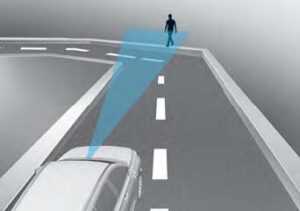 Forward Collision-Avoidance Assist may detect a vehicle, pedestrian in the next lane or outside the lane when driving on a curved road.
Forward Collision-Avoidance Assist may detect a vehicle, pedestrian in the next lane or outside the lane when driving on a curved road.
If this occurs, Forward Collision-Avoidance Assist may unnecessarily warn the driver and control the brake or steering wheel (if equipped). Always check the traffic conditions around the vehicle. - Driving on an inclined road

 Forward Collision-Avoidance Assist may not detect other vehicles or pedestrians in front of you while driving uphill or downhill, adversely affecting the performance of the sensors.
Forward Collision-Avoidance Assist may not detect other vehicles or pedestrians in front of you while driving uphill or downhill, adversely affecting the performance of the sensors.
This may result in an unnecessary warning, braking assist or steering assist (if equipped) or no warning, braking assist, or steering assist (if equipped) when necessary.
Also, vehicle speed may rapidly decrease when a vehicle or a pedestrian ahead is suddenly detected. Always have your eyes on the road while driving uphill or downhill and if necessary, steer your vehicle and depress the brake pedal to reduce your driving speed in order to maintain a safe distance. - Changing lanes
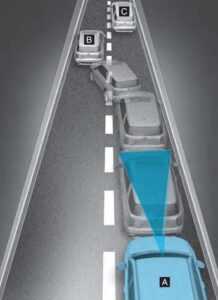 When a vehicle moves into your lane from an adjacent lane, it cannot be detected by the sensor until it is in the sensor’s detection range. Forward Collision-Avoidance Assist may not immediately detect the vehicle when the vehicle changes lanes abruptly. In this case, you must maintain a safe braking distance, and if necessary, depress the brake pedal to reduce your driving speed in order to maintain a safe distance.
When a vehicle moves into your lane from an adjacent lane, it cannot be detected by the sensor until it is in the sensor’s detection range. Forward Collision-Avoidance Assist may not immediately detect the vehicle when the vehicle changes lanes abruptly. In this case, you must maintain a safe braking distance, and if necessary, depress the brake pedal to reduce your driving speed in order to maintain a safe distance. When a vehicle in front of you merges out of the lane, Forward Collision-Avoidance Assist may not immediately detect the vehicle that is now in front of you. In this case, you must maintain a safe braking distance, and if necessary, depress the brake pedal to reduce your driving speed in order to maintain a safe distance.
When a vehicle in front of you merges out of the lane, Forward Collision-Avoidance Assist may not immediately detect the vehicle that is now in front of you. In this case, you must maintain a safe braking distance, and if necessary, depress the brake pedal to reduce your driving speed in order to maintain a safe distance. - Detecting vehicle
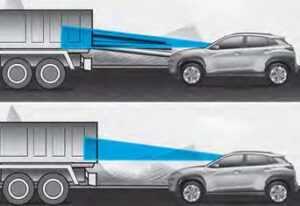
- If the vehicle in front of you has cargo that extends rearward from the cab, or when the vehicle in front of you has higher ground clearance, additional special attention is required. Forward Collision-Avoidance Assist may not be able to detect the cargo extending from the vehicle. In these instances, you must maintain a safe braking distance from the rearmost object, and if necessary, depress the brake pedal to reduce your driving speed in order to maintain distance.
Warning
- When you are towing a trailer or another vehicle, turn off Forward Collision-Avoidance Assist for safety reasons.
- Forward Collision-Avoidance Assist may operate if objects that are similar in shape or characteristics to vehicles or pedestrians are detected.
- Forward Collision-Avoidance Assist does not operate on bicycles, motorcycles, or smaller wheeled objects, such as luggage bags, shopping carts, or strollers.
- Forward Collision-Avoidance Assist may not operate normally if interfered by strong electromagnetic waves.
- Forward Collision-Avoidance Assist may not operate for 15 seconds after the vehicle is started, or the front view camera is initialized.
FAQ
Forward Collision-Avoidance Assist is a safety feature that helps prevent frontal collisions by detecting potential obstacles and applying brakes if necessary.
The system uses sensors, such as cameras and radar, to monitor the road ahead. If it detects an impending collision, it alerts the driver and may autonomously apply braking force to mitigate or avoid the impact.
The availability of Forward Collision-Avoidance Assist may depend on the trim level and optional packages of the 2023 Kona-N.
Yes, many modern systems, including the one in the 2023 Kona-N, are capable of detecting both vehicles and pedestrians in its path.
The effectiveness of Forward Collision-Avoidance Assist can vary, but it’s often designed to work at a range of speeds, from lower city speeds to highway speeds.
While Forward Collision-Avoidance Assist significantly reduces the risk of collisions, it may not be able to prevent all collisions in every situation.
No, Forward Collision-Avoidance Assist is meant to assist the driver, not replace them. Drivers should always remain attentive and ready to take control of the vehicle.
Forward Collision-Avoidance Assist might be less effective in adverse weather conditions, when the sensors are obstructed, or in situations where sudden obstacles appear.
Yes, many vehicles allow drivers to adjust the sensitivity of Forward Collision-Avoidance Assist or turn it off, though it’s generally recommended to keep it enabled for safety.
Yes, when Forward Collision-Avoidance Assist detects a potential collision, it typically provides visual warnings on the dashboard and audible alerts to prompt the driver to take action.
No, Forward Collision-Avoidance Assist is designed to operate when the vehicle is moving forward.
The distance at which Forward Collision-Avoidance Assist engages can vary, but it’s often adjustable based on the driver’s preferences.
Forward Collision-Avoidance Assist can apply significant braking force to reduce the impact’s severity, but it may not always stop the vehicle completely.
Yes, Forward Collision-Avoidance Assist has proven to be effective in reducing the likelihood of collisions and minimizing their severity in various real-world scenarios.
Useful Link
View Full User Guide: Hyundai Kona-N 2023 User Guide
Hyundai Kona-N 2023 Lane Keeping Assist (LKA) User Guide
2023 HYUNDAI KONA Specs, Price, Features, Milage (brochure)

